LCD displays are almost ubiquitous and are present everywhere from small handheld devices and computer monitors to large billboards in shopping centers and roadsides.
Before LCD we had cathode ray tube displays or the old fat TVs which used an electron gun to shoot electrons on the phosphor coating on the inner side of the screen. Then came the LCD displays in the 1980’s and started replacing the CRT tvs and displays from the market.

There were also Plasma Displays which were once popular along with the LCD displays but soon disappeared due to stiff competition from the low cost LCD’s which were more efficient, as they ran on less electricity and produced comparable brightness and picture quality.
Also Plasma displays used gasses like Neon and Xenon filled in hair thin glass tubes which was difficult and costly to manufacture. Most display manufacturers stopped making Plasma TVs around 2014-16.
However the LCD displays were here to stay as they quickly became the display of choice for all kinds of devices. They are used in smartphones, monitors, TVs and all kinds of gadgets which require a mini display.
However, there’s one technology which is quickly becoming popular in the premium smartphone and TV’s consumer market. We are talking about OLED displays which produce a better quality picture due to their deeper blacks and high contrast ratio.
History of OLED displays
Light emitting organic materials were first discovered by French scientist Andre Bernanose when he found that organic materials like Acridine dye emitted light when they were connected to an electric source.
After that in the 1960s, a New York University professor and physicist, Martin Pope found a similar organic material called Anthracene which is a chemical derived from coal tar.
However, actual OLED displays were first developed by Steven Van Slyke and Ching Wan Tang who were researchers working for the camera and photographic film making company Eastman Kodak.
If we talk about the first actual consumer electronic product which featured an OLED display, then it was in a car stereo system display made by Pioneer in the year 1997. However this display was capable of producing only one color light.
The first full color oled display was used in Kodak’s EasyShare LS63 digital camera which came in 2003.
And the first OLED tv was released by SONY in 2008.
What are OLED displays?
OLED is short for Organic Light Emitting Diodes. Organic Light Emitting materials are named so because they contain a carbon-carbon or carbon-hydrogen bond in their molecules. This type of bond is abundant in nature and organic materials.
As we said earlier, OLED materials emit light when they are connected to a voltage source. The pixels in an OLED TV are made using these materials. Before we explain the working of an OLED display we will first talk about the working of an Liquid crystal display.
Note: Some display manufacturers use the term “LED TV” for their LCD TVs but the technology they use for their display is no different from an LCD. This is just a marketing term used by them as the LEDs they use are only for backlighting and not used to create the actual pixel.
LCD displays use liquid crystals which are sandwiched between two very thin layers of glass. This LCD layer can allow light to pass through but the amount of light passing through can be controlled using the amount of voltage applied to the liquid crystal layer. It’s basically like a window which allows light to pass through but can also become dark or opaque when an electric current is applied.
In the diagram below you can see how an LCD TV or display is composed of different thin layers. The layer at the back is the backlight which is composed of tiny Light emitting diodes. Then we have the Vertical polariser which only allows a single polarization of light to pass through. It’s actually made of a thin plastic like material called PVA (Polyvinyl Alcohol) film. In layman’s terms you can simply call it a light filter.
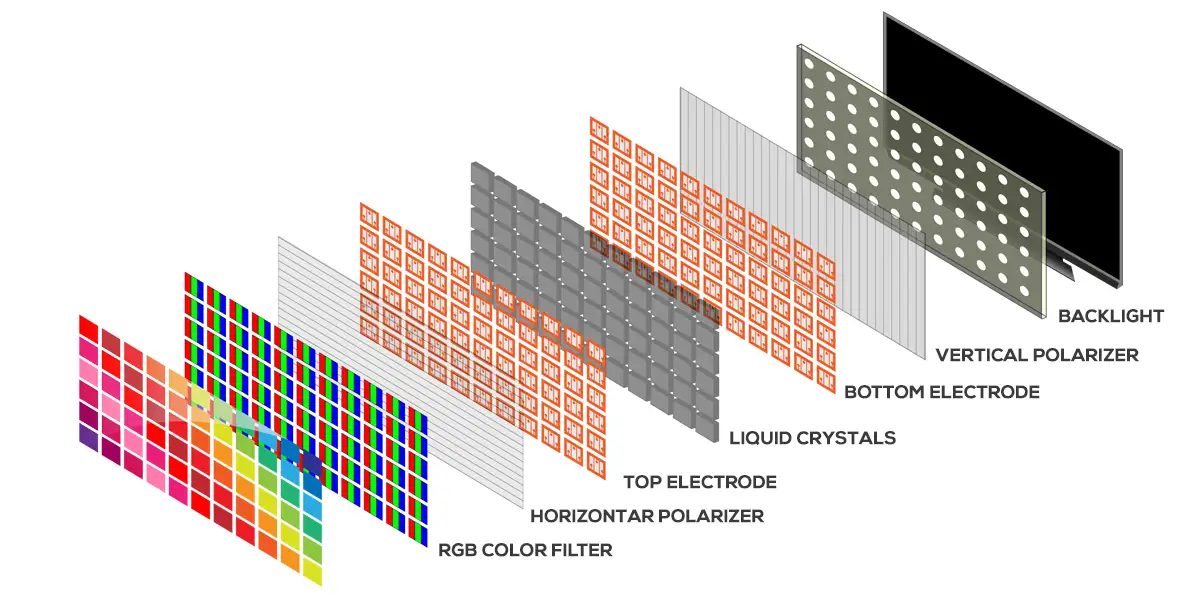
After that we have the electrode layer which consists of a thin film transistor film and a tiny capacitor layer. The TFT switch and the capacitor are a lot smaller than the actual pixel so they do not block the light passing through.
Then we have the LCD or the liquid crystal layer which contains three individual liquid crystal layers for each pixel’s red, green and blue sub-pixel. Each sub-pixel is connected to the TFT and capacitor layer. Each liquid crystal layer has its own switch and capacitor.
The capacitor stores a little bit of charge or current which keeps the pixel running for a few milliseconds before a new signal is sent. The TFT switch and capacitor allow the individual pixels to be controlled separately. This type of TFT switch and capacitor arrangement is called an Active Matrix TFT display. The earlier LCD displays used a Passive matrix LCD display which did not have a thin film transistor switch or a capacitor in them.
After the LCD layer we have the top electrode which is connected to the other end of the LCD layer. Each Liquid crystal sandwich or sub-pixel has two terminals that are connected to the top and the bottom electrode.
Then we have the horizontal polariser layer which again filters the light so that it remains uniform. Then the color filter layer provides the color to the light passing through the Liquid crystal layer. The tiny dots in liquid crystal layers create the actual grayscale image which after passing through the color filter layer appears as the actual colored image on the display.
A 4K resolution LCD TV has a total of 82,94,400 pixels and each sub pixel is further divided into three red, green and blue sub-pixel. To form an image on the screen the light emitted from the LEDs in the backlight passes through the polarizer layer and finally reaches the LCD layer. The voltage or electric signal applied to each sub pixel determines the amount of light it would allow to pass through. This allows creation of an image that has different shades of gray created by the different signals sent to the individual LCD layer pixels.
All layers allow light to pass through without any obstruction and it’s only the LCD layer which can block the light. Let’s say a pixel needs to display red then its blue and green LCD sub pixels would block all the light passing through them but the red pixel would allow light to pass through and the pixel would appear red on the screen after the light passes through the color filter layer.
If a pixel has to appear white then all its sub-pixels in the liquid crystal layer would allow light to pass through. When the red, green and blue pixels glow in full intensity then it appears white on the screen.
Working of an OLED Display
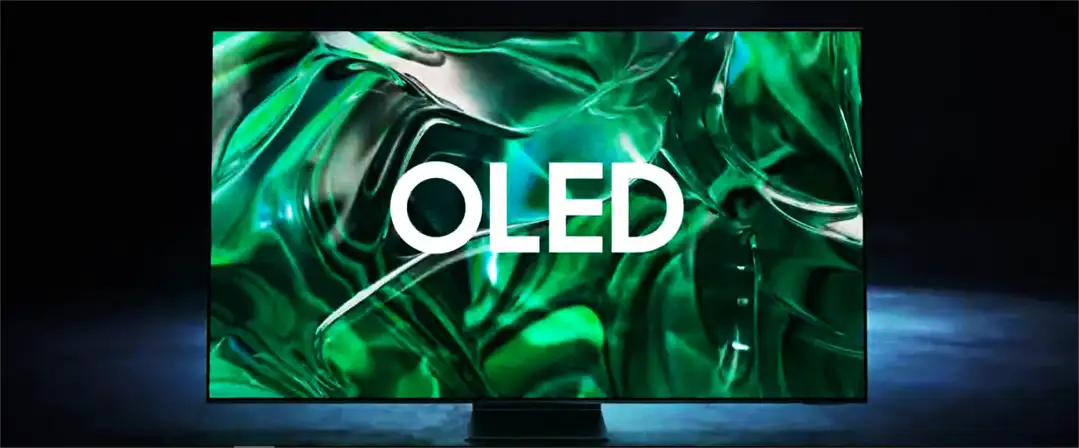
An OLED display doesn’t require these many layers to form an image. You can get rid of the back light layer, the bottom polariser layer and the Liquid crystal layer allowing for a thinner and lighter display.
The organic chemical layers of an OLED display are capable of producing their own light. They are directly connected to the top and bottom electrode layer. Then a polarizer layer is added at the top of the pixel layer which allows light to pass through in a uniform manner and also stops interference and reflections from outside light.
This is the major difference that you will find in an LCD and an OLED display. The absence of the backlight makes the display a lot thinner and lighter than an LCD display.
What is an AMOLED Display?
AMOLED stands for Active Matrix Oled Display. When Oled displays were developed initially they used a Passive Matrix Oled. Where each organic crystal was attached directly to a horizontal and vertical electrode layer.
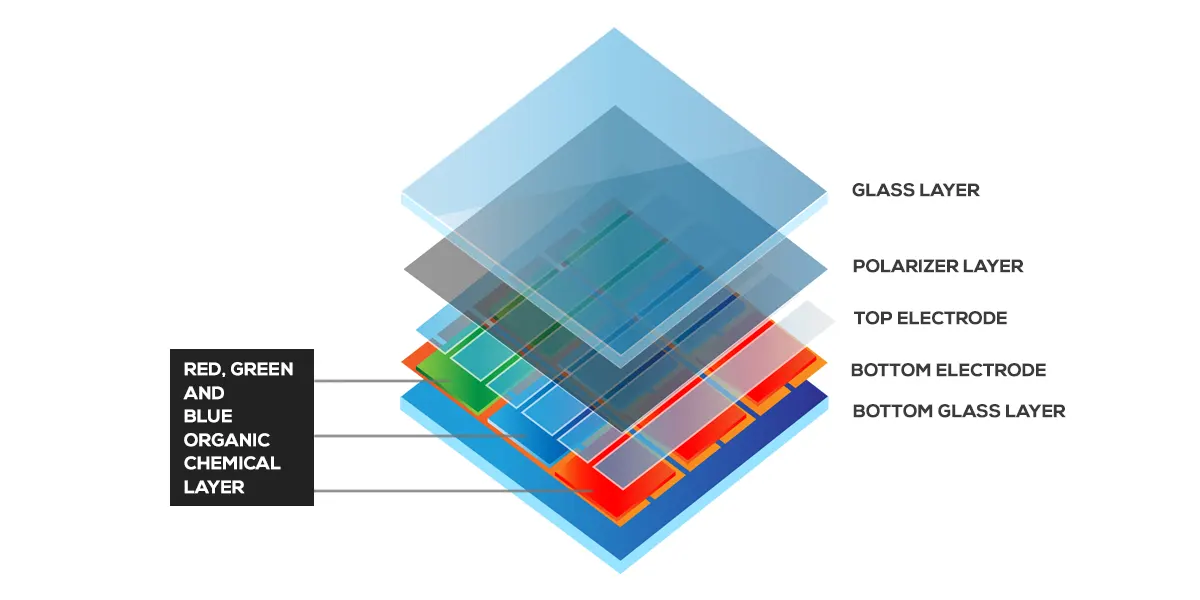
To glow a pixel a current was sent to the top and bottom, positive and negative electrode of that individual pixel. However these arrangements were not suitable for large resolution displays like TVs. The passive matrix OLED screens were limited to small displays like digital cameras, mp3 player and car stereo displays.

To create an OLED display capable of handling videos and higher refresh rates a TFT switch and capacitor was needed which would allow each pixel to be controlled separately. The TFT array of an OLED and LCD display are exactly the same but instead of being connected to the LCD layer they are directly connected to the OLED pixel in an OLED display.
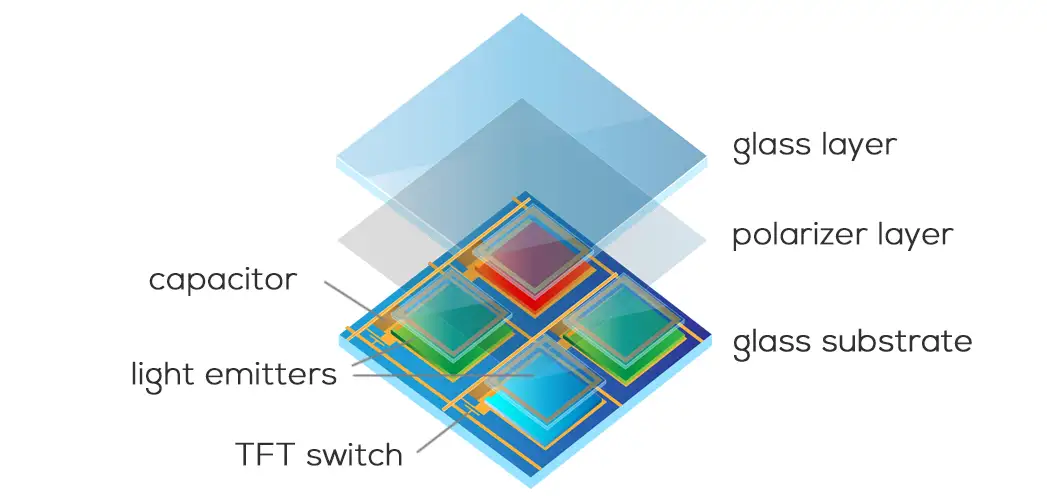
These days all displays with higher resolution like a monitor or TV use an Active Matrix Oled display also called an AMOLED in short. Even a TV marketing itself as OLED is actually using AMOLED which is necessary for making a large resolution display.
What is SAMOLED
You may have come across this term while looking for a smartphone. This is a technology used by Samsung for their smartphone displays. In SAMOLED displays there’s no difference in the display technology and it uses the same AMOLED architecture. However, the touch capacitive touch screen layer that is added on the top of the display layer is embedded with the OLED layer which allows in getting rid of an extra glass layer for covering the touch screen layer making the phone a lot slimmer and lighter.
The capability of the OLED displays to generate their own light and absence of a backlight makes them better than an LCD in many respects.
OLED Gives you Better Contrast Ratio
In technical language the Contrast is the ability of display to show the whitest white and the deepest black color. It’s also the difference in the intensity of two colors being displayed side by side. The higher the difference the better the contrast ratio or the image quality you will get.
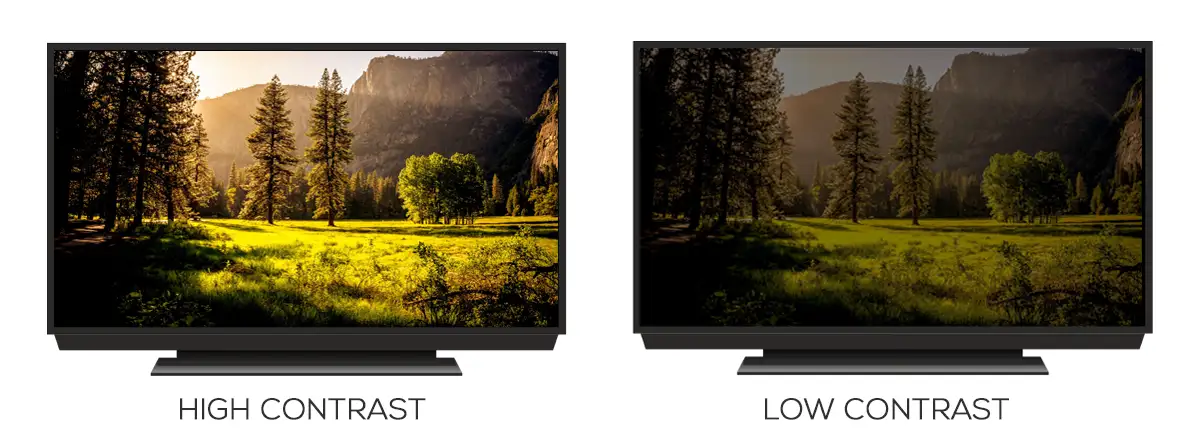
Deeper Blacks in OLED
OLEDs do not need a backlight and therefore they do not suffer from issues like light bleed. Light bleed is common in many entry level LCD displays where you would notice slight fading of color at the corner or the edges of the screen. This is more noticeable when your display is showing an image with deeper colors.
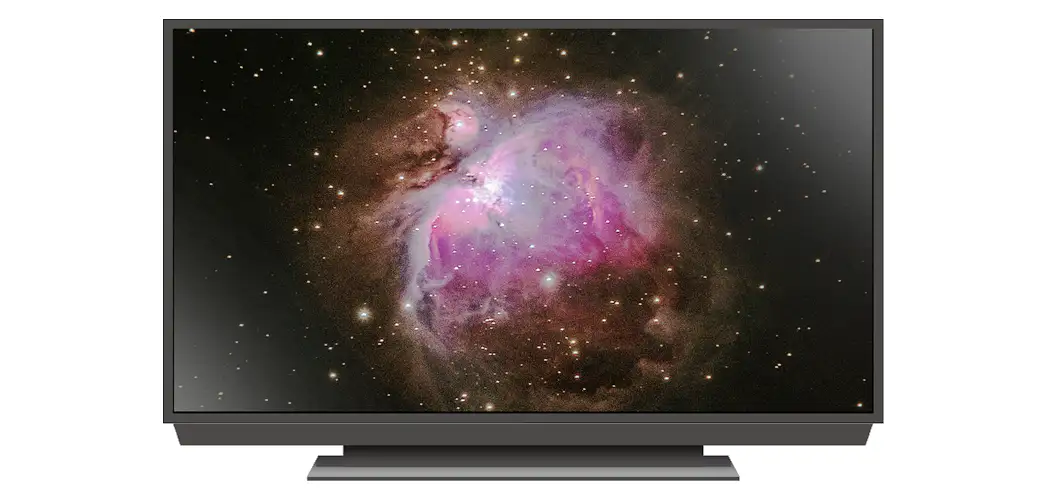
OLED pixels generate their own light and are capable of switching off individual pixels when they are not needed. This allows them to display the true deep black color or shaded in an image.
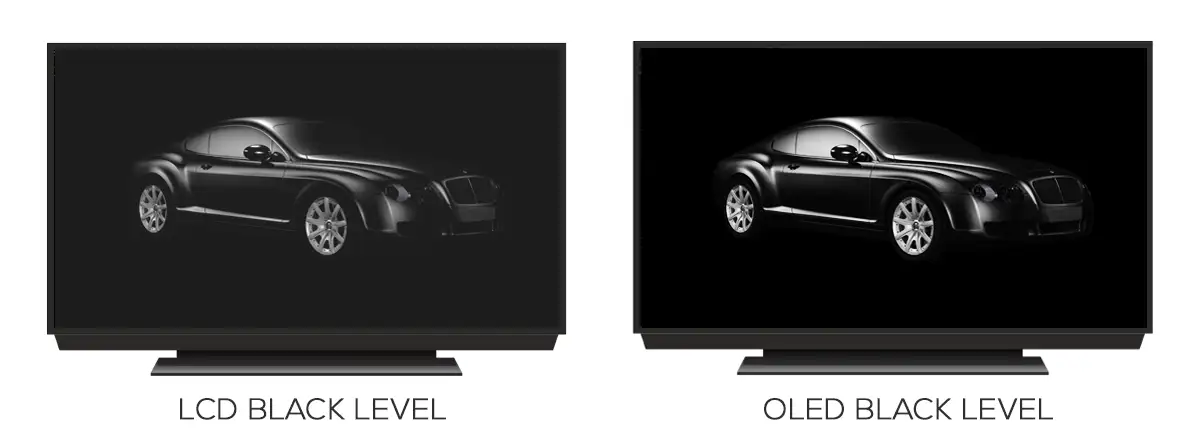
Apart from that, the Liquid crystal layers are not capable of blocking all the light from passing through even when they are showing the black color. Some latest LCD’s use a technique called local dimming to counter this issue of light bleed. Where the LED’s in the backlight can be switched off when the pixels exactly above them are displaying black color.
However, this requires small LEDs thus increasing their quantity and making these displays a bit costlier than their counterparts.
Better Viewing Angle in OLED
The LCD monitors and TVs in their beginning years suffered from this issue a lot where the colors on a display appeared faded when you viewed them outside a 120 degree angle in front of the display.
This happened because of the multiple layers and polarizers that mostly allowed light to be emitted in a straight line. OLEDs do not suffer from this limitation and the viewing angle is almost 180 degrees.
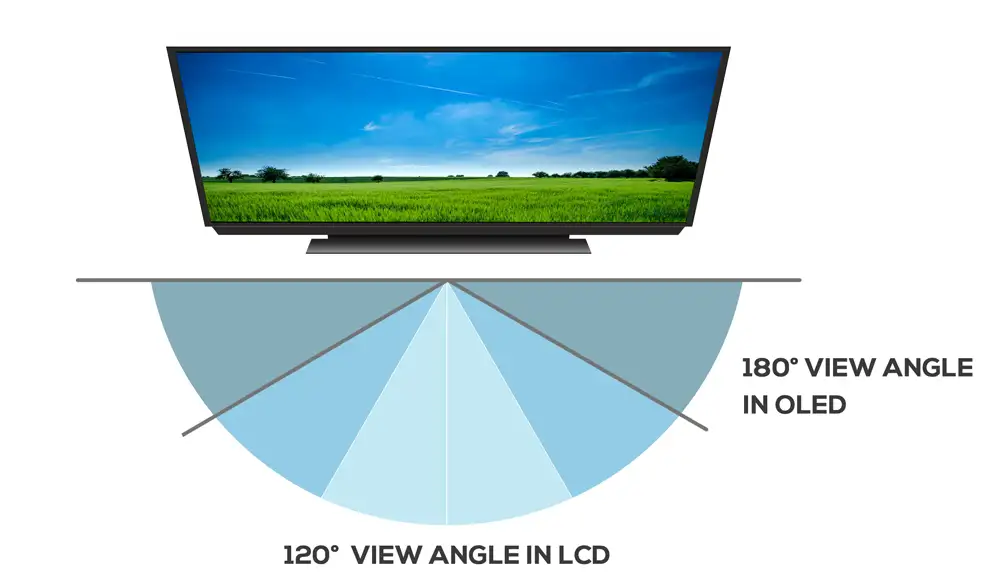
However, in recent years LCDs have significantly improved their viewing angles. An LCD display with IPS capability uses an improved arrangement of the pixels to increase the contrast and color producing ability of the display. It also improves the viewing angle. However, they may have lower refresh rates and may be a bit costlier than the average LCD display.
OLED Screens Use Less Electricity
The electricity consumption in an LCD itself is less when compared to other electric appliances. However, it’s almost twice when compared to an OLED display of similar resolution and brightness.
This is more significant when we have smartphones running on battery power. An OLED display on a smartphone would consume a lot less power compared to a LCD display as there is no need for backlight to run continuously. A single charge would last 50% more on an OLED display smartphone.
LCDs are Budget Friendly
OLED displays are mostly used in high end TVs and monitors. Most of the entry level smartphones and TVs use LCD displays which offer comparable picture quality. Also the resolution and size of an OLED tv is limited when compared to LCD’s which are offered in many resolutions and sizes.
You may have to spend 3 or 4 times more to buy a display with an OLED when compared to a similar resolution LCD display.
Total Brightness Level better in LCD
This may come as a surprise to you but the total brightness of an LCD tv can be increased significantly by increasing the LEDs in its backlight. This is not the case with an OLED tv whose pixels produce light in a fixed wavelength.
Moreover, the UV rays in the sunlight can damage the organic chemicals in the OLED layer. LCDs have liquid crystals which do not get damaged easily also the backlight used LEDs which can last for decades.
LCDs Do not Suffer from Screen Burn
Screen burn happens when the LCD layer is not able to produce the right color. This rarely happens in an LCD but this is more common in the OLED displays especially when you use your display at the 80 to 90% brightness levels.
OLED uses organic chemicals which lose their ability to produce the right intensity of light or color. In some cases the specific areas of the screen where pixels glow more brightly or continuously without getting refreshed such as the icons on the homescreen of a phone. The navigation buttons and the notification bar also suffer from the issue of screen burn in oled displays.
However, this can be avoided if you keep the brightness level of an OLED display below the 50% threshold.
LCDs Last Longer
The average lifespan of an LCD display is 20 to 30 thousand hours. However, OLEDs last a lot less at 12,000 to 15,000 hours of usage. They may degrade a lot earlier if you keep the brightness at the near maximum levels.
